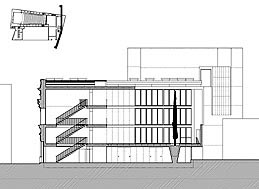


Centro cultural El Musical
El Musical cultural centre
Valencia |
 |
 |
|
| Eduardo de Miguel Arbonés |
Centro cultural El Musical El Musical cultural centre Valencia |
Premio COACV 2003-2004/2003-2004
COACV Prize
Obras de Arquitectura/Works of
architecture

| La
intervención se realiza sobre las preexistencias del antiguo Ateneo
Musical del Puerto situado en el barrio del Cabanyal de Valencia, un
inmueble en estado de ruina que ha hecho inviable su conservación. El único
elemento que se mantiene es la fachada recayente sobre la plaza del Rosario para preservar el carácter
del espacio urbano más emblemático del barrio.
El nuevo edificio está compuesto de un centro cívico, una sala polivalente para música, teatro y espectáculos públicos, con capacidad para 400 espectadores, y un área de servicios. La práctica totalidad del perímetro del solar sobre el que se interviene está configurado por muros medianeros, siendo imposible establecer una relación directa con el exterior. La característica más acusada de la intervención es la propuesta de un muro de doble hoja que contiene los elementos de circulación y permite introducir luz natural a través de él. La tensión del proyecto se produce entre los espacios de comunicación alojados en el intersticio entre los dos muros y los espacios públicos que ocupan los vacíos creados en el interior. El foyer, espacio de encuentro entre el centro cívico y la sala, está iluminado cenitalmente y tamizado con un velo de listones de madera que se desliza hasta el suelo. |
The project works on the
remains of the old "Ateneo Musical" in the Cabanyal
neighbourhood, near the port of Valencia. The only element which is
retained is the façade on the Plaza del Rosario, in order to preserve the
character of the most emblematic urban space in El Cabanyal. The new building is composed
of a civic centre, a multipurpose hall for music, theatre and public
spectacles, with capacity for 400 spectators, and a service area.
The site's perimeter is formed by the existing party walls with the
neighbouring buildings, making it very difficult to establish a direct
relationship with the surroundings. The most evident
characteristic of the intervention is the double wall which contains the
circulation elements and allows the entry of natural light. The
tension in the project arises between the communication spaces
placed between the two walls and the public spaces that occupy the voids
created in the interior. The open space of the entrance hall, the meeting
place between the civic centre and the main hall, receives light from
above, veiled by wooden strips that filter the light and continue down to
the floor. |

|
Emplazamiento / Location: Situación/Location Promotor/Developer: Colaboradores/Collaborators: Fotógrafo/Photographer:
|
 |
 |
 |
|
 |